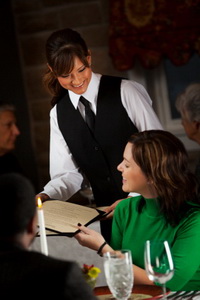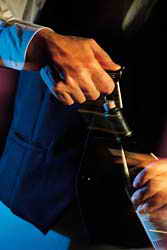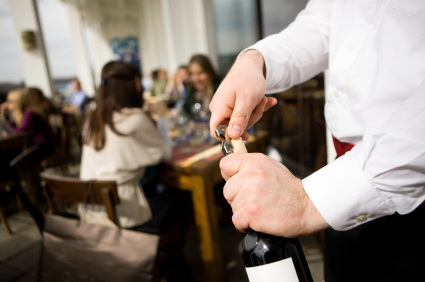Bringing your own bottle of wine to restaurants is now legal in many provinces and states, but what are the rules of engagement?
I shared some tips on CBC radio this week on the etiquette of doing so, including the types of wines to bring, corkage fees and tipping.
Does the thought of bringing your own wine to a restaurant make you feel cheap and arrogant? Get over it by practicing good BYOB etiquette.
1. Even when the practice is legal, check if the restaurant allows or encourages it. When you make the reservation, ask if you can bring a special bottle to celebrate your birthday—even if it was four months ago and you’ve celebrated it weekly ever since.
2. Although you may not get a flat-out no, you may sense some resistance in the tone of voice or in the cheery information that you certainly can, but the corkage fee is $100. Then it’s best to take your bottle elsewhere.
3. Sometimes a restaurant will have no problem if you bring one bottle to drink—but they’ll look askance at two or a whole case. It’s best to check about this beforehand too.
Still, you may want to bring a spare bottle just in case the one you open happens to be corked: otherwise what will you do, send it back?
4. Take wines that can handle some jostling and won’t be traumatized by the trip. Some older wines are fragile and those with a lot of sediment could take several hours to settle down to a drinkable state again. 
You can still enjoy a mature wine, just be sure that it can take a bit of jostling. As well, be extra careful with sparkling wine—spraying the other diners is considered bad form, even in a BYOB establishment.
5. Don’t take your best wines if the restaurant has poor glassware—it’s an injustice to a great wine to be suffocated in one of those golf-ball-sized glasses. If the place allows it, bring your own stemware.
6. Take several half bottles of wine so you can match different wines and dishes. Have compassion for the dishwasher though and don’t bring a ridiculous number, especially for large groups.
7. What if you’re not sure just what you’ll feel like eating when you get to the restaurant? Two of the most versatile and food-friendly wines to take with you are riesling and pinot noir: lots of flavor and great acidity to refresh the palate between bites.
8. Avoid taking bottles that are already on the restaurant’s list, unless you have a much older vintage that they don’t stock. And unless you’re an award-winning amateur, skip the homemade wine.
9. Most BYOB restaurants allow only table wine—beer, spirits and fortified wines are mostly discouraged or even illegal. Check to see what types of alcohol are permitted.
10. Consider buying an insulated wine case. It will protect the wine and keep it at the right temperature. Some even have compartments for glasses, which is helpful if the restaurant doesn’t have good stemware.
 Many cases come in chic designs and lend a certain aplomb that clinking bottles in a plastic grocery bag just don’t.
Many cases come in chic designs and lend a certain aplomb that clinking bottles in a plastic grocery bag just don’t.
11. If the restaurant is casual, and if there are just two of you, put one bottle on the table; leave any others in your case under the table. Larger groups can set out enough bottles for everyone to start with a glass of wine.
12. Sometimes it’s possible to ask the server to store your wine in the kitchen—more formal restaurants may prefer this, finding your bag under the table a tad inelegant no matter how chic the design.
There are drawbacks to this. One is that your precious Pétrus could be accidentally substituted for plonk. And often small operations don’t have the space or proper conditions to store your wine.
13. In casual restaurants, topping up your wine is usually acceptable, but may be discouraged in more formal settings.
14. Unless the restaurant’s wine list is horrible, consider buying a glass to whet your appetite—if only as a goodwill gesture. A sparkling aperitif is ideal—and the wise diner wouldn’t try transporting such an unstable wine.
15. It’s also good form to offer a glass of your wine to the server. He or she can drink it, decline it or accept it to share with the chef.
16. When it comes time to tip, remember that your server has done just as much work opening and pouring your bottle as one from the restaurant’s list.
Give what you would have if you had bought the bottle there. You save money on your total bill, not by stiffing the servers, most of whom make 80 per cent of their income from tips.
17. Don’t abuse BYOB establishments by treating them as a cheap place to drink, ordering very little food and drinking lots of your own wine.
Bringing your own wine to a restaurant is a privilege, not a right; and BYOB restaurants won’t last unless we support them honorably.
Here are several excellent articles on BYOB:
BYOB in BC Restaurants – Mari Kane
BYOB in San Francisco – East Bay Express
BYOB Etiquette – Wall Street Journal Smart Money
BYOB Wine Tips – CBS
Craig: Now another change in store for Saskatchewan. It is something that is going to be music to wine lovers ears. Today the government will allow restaurants to offer ‘bring your own wine’ to customers.
This is known as corkage and it’s already legal in six provinces including Alberta, and Manitoba. Natalie MacLean is a wine expert and writer. She said this is a very good move for wine lovers in Saskatchewan. Natalie joins me now from Ottawa. Good afternoon, Natalie.
Natalie: Hi, Craig.
Craig: Why do you think that ‘bring your own wine’ is a great concept for restaurants in Saskatchewan?
Natalie: I think it’s a great concept for both restaurateurs and for wine lovers. For restaurateurs, I think, it gives them another tool or way to serve their customers that I think is very valuable. Here in Ontario, what a lot of restaurants do is offer the BYOB service on a Sunday or Monday night, when traffic is slowest…
Craig: Okay.
Natalie: …to encourage wine lovers to come out, bring that special bottle and have a great meal with it. So it works both ways.
You know, there are a lot of great bottles out there that you can’t get on restaurant lists, or, you’ve been saving that special bottle for 10 years. There’s no way a restaurant can afford to keep a wine in storage that long. It ties up too much cash. So, there’s a lot of great reasons to offer this service.
Craig: So, just paint this picture for me. When I walk into a restaurant at some point in the future in Saskatchewan, carrying my own bottle of wine, what charges can I expect? What reception can I expect from the waiter? How does it all work?
Natalie: I would expect it would vary by restaurant. Restaurants decide whether or not they even want to offer the service because it’s legal but not mandatory.
Some choose to offer it on slow serve nights like Sunday, Monday or maybe earlier in the evening, 5 to 7 PM or full service all the time.
One of the things that I do advise people is to call ahead and make sure the restaurant is offering the service and ask if there are any other parameters and so on? Then, you will feel more comfortable about it.
When you arrive, you should expect that you are going to pay a corkage fee. That’s the cost, the fee to open the bottle and serve it. The adage in the restaurant industry is that customer will eat you poor and drink you rich. A lot of the profit margin is in the drinks; not just the alcohol but coffee, tea and water.
The restaurant is still providing that full service and still has to pay that overhead which is not covered, generally, by the food. So you’re going to pay whatever it is, depending on the establishment, anywhere from $10 to sometimes even $30, if you are at a fancy place. But that’s an expected part of this.
Craig: So, the $30 corkage fee goes to the restaurant. That’s to allow you the privilege to bring your own bottle of wine.
Natalie: Exactly, On a restaurant wine list, that bottle of wine would be marked up anywhere from 50% to 100%. You are not paying that. You are paying for the service that is still a component of serving you that wine and also the total cost of your meal, much of which is in the drinks.
Craig: So you say it’s not mandatory, of course. How many restaurants, generally speaking, take advantage of this and offer corkage?
Natalie: I find the restaurants with better wine lists do it because they are catering to a wine loving crowd who have an interest in wine or have rare and special wines.
Another tip that I often offer is don’t bring a bottle that’s already on the restaurant list. Try bringing one that the restaurant doesn’t serve or an older vintage that can make an anniversary dinner special.
Craig: Of course, everybody likes to talk about tipping. What would be some of the right ways to tip when it comes to that corkage fee? Do you tip on it or not?
Natalie: Yes, don’t be a cheese ball. It isn’t about saving a dollar-fifty.
Just as there’s a corkage fee for the service, there is a normal built-in price that would have been for that bottle of wine. Your server depends on tips. Your server, sommelier, depending on the kind of specialty staff they may have, are often paid minimum wage and depend on the tips for their living. And often, the big part on the tip is on the alcohol.
So if you are tipping 15% , 20% or whatever you do on a normal basis, that’s not going to be in your end bill. It’s just on the $20 fee. That’s not the time to be cheesy about tipping. You want to think about what the cost of that wine was. There are limits of course … like if you brought an astronomically priced wine, okay? Some do a percentage, but consider that had you purchased that wine from the restaurant list, what would you be tipping at that point.
Craig: Natalie, thank you.
Natalie: Absolutely! I’ve got lots of BYOB bottles you can bring at nataliemaclean.com.
Craig: Thanks again.
Natalie: Okay, Craig.
Craig: Bye-bye.
Natalie: Bye-bye.
Craig: That’s wine writer, Natalie MacLean. She’s from Ottawa. And we were just talking about the fact that one of the proposed changes is that you may be able to bring your own bottle of wine to a restaurant should they permit it. And you just pay your corkage fee which can range from very little to around $35 on the high end on the spectrum.
Posted with permission of CBC








